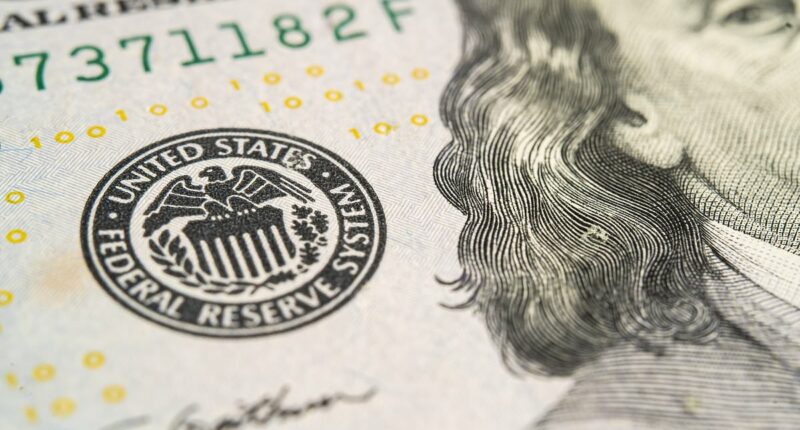Share this @internewscast.com
Once again, the Federal Reserve seems poised to play the role of savior, a prospect eagerly anticipated by the markets in the coming weeks. As Wall Street grapples with recent turbulence, the prospect of cheaper money is seen as a key factor to fuel a recovery.
Current expectations are that the Fed will implement two quarter-point interest rate cuts this year, with the first anticipated at its upcoming meeting at the end of the month.
Should the situation become increasingly unstable, a more aggressive half-point reduction cannot be ruled out.
The nature of markets is such that surprises often exert more influence than underlying fundamentals. Recent disruptions at a couple of medium-sized US banks have dampened market spirits, overshadowing concerns that the exuberance surrounding artificial intelligence might have gotten out of hand.
Amidst speculation about the right time to exit from major tech stocks due to the risk of a crash that could end a remarkable bull market, the unexpected jolt came not from the flashy world of AI but from the so-called mundane banking sector.
On a practical level, this scenario presents a silver lining. It offers the Federal Reserve a compelling justification to proceed with rate cuts.

Support: The Federal Reserve is expected to deliver two quarter-point cuts to interest rates this year
There already was one: a soft jobs market. Everything here in Washington is confused by the government cutbacks and now the shutdown. But as the Fed chair, Jerome Powell, acknowledged last week, employment growth is easing.
The Fed is usually said to have a dual mandate from Congress: price stability and promoting employment. Since inflation is more or less under control, a rate cut would help the latter.
It also has another, less well-known requirement, which is to promote moderate long-term interest rates, and that would fit in with rate cuts too.
Now, aside from the case for cheaper money to help fulfil the Fed’s mandate, there may well be the need to calm the markets.
We’ve seen it time and again. If there is panic, pump in money, or as they put it, supply liquidity.
Not a great idea in the long term. As we saw with so-called quantitative easing, you end up with more inflation. But in the short run that’s what you do.
I don’t think the markets are yet in full-on scare story mode. Some huge asset managers are still bullish. For example, Mark Haefele, chief investment officer at UBS Global Wealth Management, says: ‘We expect further gains for AI-linked stocks over the coming year.
‘Beyond AI, we see additional supportive factors for equities, including better-than-expected US economic growth and lower US interest rates.’
That may be over-optimistic. But as far as we can be confident about anything I think we can be sure that if current wobbles develop into something really nasty, the Fed will do its utmost to keep things under control.
What does all this mean for us?
Well, for a start, it is good news for Chancellor Rachel Reeves. We don’t have the freedom over monetary policy that the Fed has, and we have substantially higher inflation.
But the combination of worries about US banks and the likelihood that the Fed will cut rates has already reduced the interest payable on US government debt and, since these things go in kilter, also on the UK’s debt.
Our ten-year debt has been at a 4.7 per cent rate of interest for most of the past month.
On Friday it dipped below 4.5 per cent before climbing a bit in the afternoon.
By recent standards that’s still high, and it doesn’t make Reeves’ Budget numbers materially better. However, it is a move in the right direction.
More generally, we need a Fed that is seen to be competent within the US, and one that commands respect across the rest of the world. American money is so, so important. US stocks account now for more than two-thirds of the global total.
The Fed is under huge political pressure from Donald Trump’s administration – with the endless and frankly rather juvenile attacks on Powell from the President – and that is troubling.
We don’t know who will succeed him when he retires this spring, but we have to hope that the institution’s reputation remains solid.
My feeling is that the next few weeks will show that the US markets have been right to trust the Fed.
Fingers crossed that’s right.
DIY INVESTING PLATFORMS
AJ Bell

AJ Bell
Easy investing and ready-made portfolios
Hargreaves Lansdown

Hargreaves Lansdown
Free fund dealing and investment ideas
interactive investor

interactive investor
Flat-fee investing from £4.99 per month
InvestEngine

InvestEngine
Account and trading fee-free ETF investing
Trading 212
Trading 212
Free share dealing and no account fee
Affiliate links: If you take out a product This is Money may earn a commission. These deals are chosen by our editorial team, as we think they are worth highlighting. This does not affect our editorial independence.
Compare the best investing account for you







